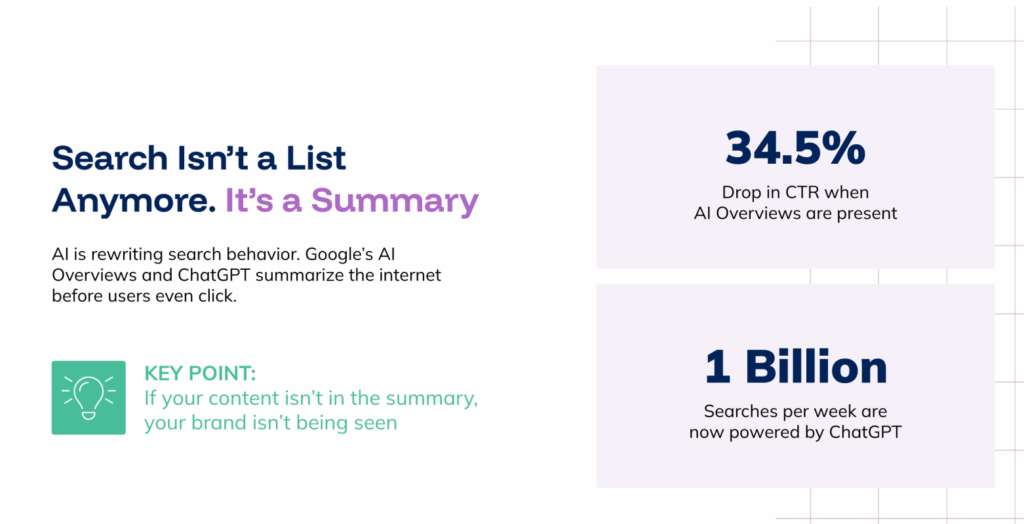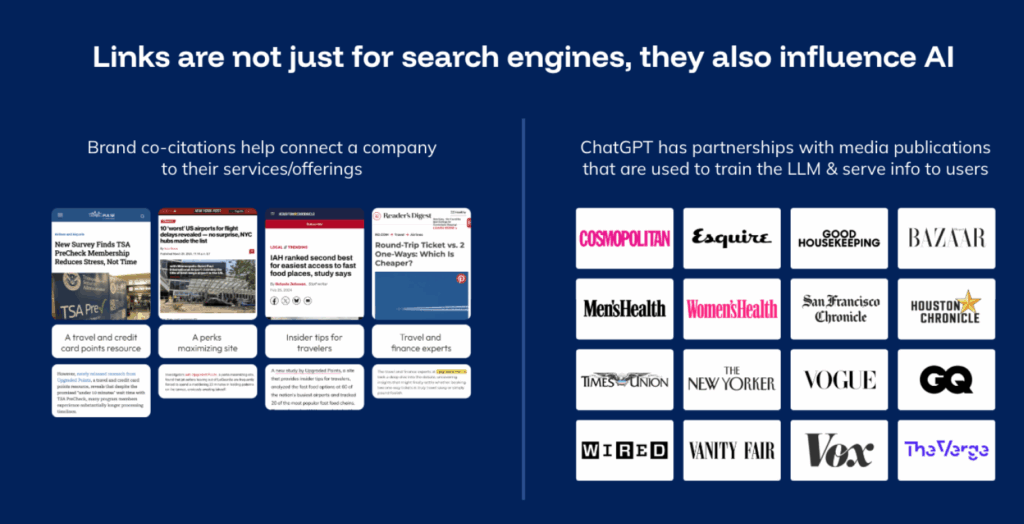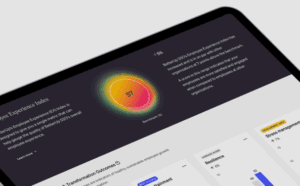Home / Blog / The New Rules of AI Search: How PR and GEO Shape Visibility, Revenue, and Competitive Advantage
AI GEO Go Fish Digital seo
The New Rules of AI Search: How PR and GEO Shape Visibility, Revenue, and Competitive Advantage
Published: October 06, 2025
Share on LinkedIn Share on Twitter Share on Facebook Click to print Click to copy url

Contents Overview
When buyers turn to ChatGPT, Gemini, or Perplexity, they expect instant answers, not lists of links. If your brand is missing from those answers, the opportunity to win attention, trust, and pipeline is already gone.
That gap has real financial consequences. Missed visibility means higher customer acquisition costs, fewer inbound leads, and lost pipeline. Boards and investors are already asking marketing leaders about AI readiness.
As Kalina MacKay, SVP of Owned Media at Go Fish, puts it: “Search isn’t a list anymore. It’s a summary. If your content isn’t in that summary, your brand isn’t being seen.”
Why PR Matters as Much as SEO
For years, SEO teams focused on optimizing their own websites. But AI engines look beyond your domain. They prioritize third-party validation, media coverage, and context to decide what brands to trust.
Research shows that three out of four AI answers cite PR-driven content like reviews, articles, and interviews. For SaaS brands, that could mean being cited in “best productivity software” prompts. For insurance providers, it could mean inclusion in “most affordable coverage” queries. For consumer brands, it is about whether reviews and product mentions appear in AI shopping summaries.
As Lanie Martin, Digital PR Manager at Go Fish, explains: “In an AI-first world, citations are currency. The more your brand is mentioned in credible outlets, the more likely you are to be included in generative answers.”
Visibility has a measurable cost. When AI Overviews dominate the SERP, click-through rates drop by 34.5%. If your competitors are in the summary and you are not, they capture the demand that would otherwise be yours.

How AI Engines Select Sources for Search Visibility
AI engines weigh authority differently than Google’s traditional ranking algorithm. They focus on semantic similarity, structure, and consensus across multiple sources.
Patrick Algrim, Senior SEO Strategist at Go Fish, explains: “Visibility hinges on semantic alignment and external validation, not just keyword rankings. If your content isn’t structured for AI, you’re not part of the conversation.”
That means your content must align with how buyers actually phrase their questions and tasks. A SaaS brand answering “how to integrate CRM with email marketing” is more likely to surface than one optimized only for “CRM integration.”
Structure is another key factor. Adding Q&A blocks, bulleted lists, or detailed headers makes content easier for AI systems to parse. In fact, adding structured Q&A increased organic sessions by 28% in one case study because the content became more usable for both humans and machines.

Finally, external validation still tips the scales. Brands consistently mentioned alongside industry-relevant terms in credible outlets are more likely to be cited.
Backlinks and Co-Citations Still Drive Visibility
Backlinks remain essential, but AI engines now also reward co-citations: mentions of your brand in context with your offerings.
If ChatGPT repeatedly sees your brand mentioned next to “enterprise HR software,” it strengthens the connection. For a home goods company, that could mean being associated with “best eco-friendly furniture.” For multi-location services, it could mean consistent mentions in local media tied to brand name and industry.
As MacKay puts it: “Backlinks are critical in 2025 to keep up with the changing search landscape. You can earn them through creating content tailored to journalists.”
The takeaway is simple. Backlinks validate authority, while co-citations establish relevance. Both are required for AI visibility.
Building Campaigns That Influence AI
The campaigns that shape AI visibility are intentional, not accidental. Brands need to create coverage opportunities that earn citations across the right sources.
Data-driven campaigns are especially effective. Proprietary research or surveys provide fresh insights for journalists to cite. An insurance company publishing annual data on climate risk coverage, for example, not only attracts coverage but also positions the brand in AI answers about homeowner risk.

Tangential content also works well. A SaaS company could create a study on “the most efficient industries for hybrid work,” earning coverage beyond tech press while reinforcing its expertise in productivity solutions. Consumer brands might explore lifestyle angles, such as “best cities for eco-friendly living,” to secure coverage that indirectly boosts authority.
As Martin emphasizes: “Journalists want fresh data. When you provide insights that inform their stories, you establish yourself as a reliable source, and your brand earns the mentions that AI pays attention to.”
Measuring Success in an AI-First World
For CMOs and VPs, measurement must shift from surface metrics to authority-building outcomes. Traffic and impressions matter, but they do not reflect whether you are influencing AI-driven visibility.
At Go Fish, we measure success by tracking backlinks earned, growth in referring domains, and improvements in Domain Rating (DR). On average, consistent PR campaigns deliver a three-point DR increase annually, a compounding signal of authority.

Keyword gains also connect directly to AI visibility. SimpleTexting, one of our clients. achieved a 308% increase in keywords ranking in positions 1–3 alongside stronger domain authority. Those rankings translated into more frequent appearances in AI Overviews.
As Algrim explains: “AI visibility is built on consensus. The more signals pointing to your brand, links, mentions, structured content, the more confidence AI has in surfacing you.”
What This Means for Marketing Leaders
For executives overseeing marketing budgets, the implications are clear. SEO and PR are no longer separate disciplines. Each matters, but neither is sufficient in isolation.
PR ensures your brand is included in the sources AI trusts most. SEO ensures your site is structured and semantically aligned with how buyers search. Together, they deliver visibility that lowers CAC, protects pipeline, and positions your brand ahead of competitors in AI search.
As Martin explains: “Digital PR improves visibility by shaping what AI learns about your brand.” For leaders scaling SaaS, managing insurance portfolios, selling consumer goods, or overseeing multi-location services, this integration is not optional. It is the foundation of competitive growth.
FAQs About AI + PR Visibility
Do backlinks still matter for AI visibility?
Yes. Backlinks remain a strong authority signal. But AI engines also weigh co-citations and brand mentions, making the quality and context of links more important than sheer volume.
How does PR influence AI search?
Media coverage and reviews are frequently cited in AI answers. PR-driven mentions act as validation signals that increase the likelihood of your brand appearing in generative results.
What is the difference between SEO and GEO?
SEO focuses on traditional rankings. Generative Engine Optimization (GEO) adapts SEO for AI engines, emphasizing semantic similarity, structured content, and external authority signals.
How long does it take to see results?
Most brands see measurable progress in three to six months. With consistent campaigns, authority compounds over time, leading to stronger visibility in both search and AI.
How do AI Overviews affect traffic?
Click-through rates drop by 34.5% when AI Overviews are present. That makes it even more important to ensure your brand is cited within the overview itself.
What tools help track AI visibility?
Traditional tools like Ahrefs and SEMrush can help track keywords and backlinks. At Go Fish, our proprietary AI Visibility Audit identifies how often your brand is cited in AI answers compared to competitors.
Which industries are most at risk?
For SaaS, it’s being cited in ‘best software for X’ prompts. For insurers, it’s showing up in ‘most affordable coverage’ queries. For home goods brands, it’s product mentions in shopping answers. In every case, missing citations means missing revenue.
The Bottom Line
AI has changed the rules of digital visibility. For CMOs and marketing leaders, the stakes are high. If your competitors are cited in AI answers and you are not, they capture market share, drive down their CAC, and win attention earlier in the buying journey.
PR fuels the citations that AI trusts. SEO ensures your site is structured and semantically aligned. Together, they build the authority signals that secure visibility where decisions are being made.
The companies that align PR and SEO now will not just be visible. They will own the summaries buyers see first, protecting pipeline and outpacing competitors.
See Where You Stand
Request a free AI Visibility Audit to uncover how your brand appears in AI-powered search and what it will take to outperform competitors.
About Kimberly Anderson-Mutch
MORE TO EXPLORE
Related Insights
More advice and inspiration from our blog
How to Earn Media Coverage and Backlinks Without High Domain Authority
You don't need high domain authority to land media coverage. Learn...
Top Google Ads Mistakes to Avoid in Q4 (And How to Fix Them)
Are hidden Google Ads mistakes draining your budget? Learn how to...
Kimberly Anderson-Mutch| August 27, 2025
Mastering the Art of Digital PR: Two Key Steps to Crafting a Killer Outreach Strategy
Developing a bullet-proof outreach strategy is vital for a successful Digital...





